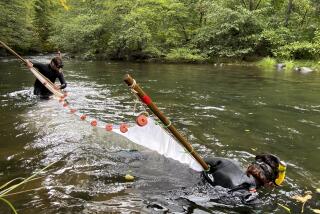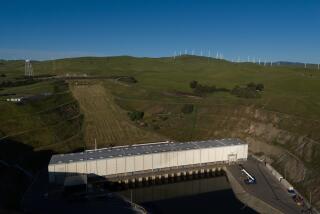Heavyweight Fishing Season Was Practically Off the Scale
With the beginning of every new year comes a time to reflect and resolve.
For Southland fishermen, of course, this means looking back on one of the best years on record and hoping for more of the same come the warmer months of 1998.
The top story was the onset of El Nino, which had anglers up and down the coast knee-deep in tuna for seven months.
Here are some 1997 catch totals compiled this week by Department of Fish and Game biologist Steve Crooke:
--73,114 yellowfin tuna.
--60,156 albacore tuna.
--24,708 skipjack tuna.
--6,327 bluefin tuna.
And these are fish caught only aboard full-day and 1 1/2-day party boats operating out of landings from Morro Bay to San Diego. They do not include the additional thousands of tuna caught aboard multiday boats or smaller six-passenger charter vessels, or the additional thousands of tuna caught by private boaters, which were out in force this season because of the unusual proximity of the fish--at times as close as five miles offshore.
Nor do Crooke’s figures include the ungodly catch of albacore landed north of Morro Bay aboard party boats and private boats--with landings believed to be well in excess of 100,000--that started May 31 and is still in progress.
And if the tuna weren’t enough, anglers aboard party boats caught 427,667 yellowtail and 29,471 dorado, Crooke said.
“What’s interesting about that,” he says, “is that Dana Point and Oceanside, two of the smaller landings, produced 88,745 yellowtail. They were at the center of it all, accounting for about 20% of the landings while carrying only about 8% of the passenger load.”
What’s also interesting about all this is that when the log books from San Diego’s huge fleet of multiday boats are studied in the coming weeks, the numbers are going to rise, making one of the all-time great seasons even better.
According to Crooke, the 1997 yellowtail season probably will turn out to be the best ever, with landings topping the 457,000 caught in 1959.
The 1997 yellowfin tuna season, not counting multiday trips, was second only to that of 1983--the summer after the last major El Nino--when 116,000 were caught aboard party boats from Morro Bay to San Diego.
“Albacore will end up in the top 15 ever recorded statewide, bluefin will be in the top 10 and skipjack will be in the top 10,” Crooke said. “It’s just been an incredible season. It started in May and it’s still going today.
“They caught 2,000 yellowfin in May and 6,000 albacore in May. I mean, if you stop and think about it, it’s just been an incredible year.”
They’re shaking their heads in disbelief north of Morro Bay as well.
Said Bat Batsford, president of the Bay Area Tuna Club: “We are still in the best albacore season any of us have ever seen, and I’ve been fishing for albacore for 52 years. . . .
“In November and December, we had albacore from 40 to 80 pounds within eight miles of Santa Cruz Harbor. Morro Bay has them 18 miles out. God only knows what’s on the outside--everyone is too spoiled to run more than 20 miles.”
With all this in mind, the top catch of 1997--south or north of Morro Bay--has to go to Don Giberson of Milpitas. The 43-year-old computer company executive quit his job so he could take advantage of a “once in a lifetime” albacore season.
He spent more than $2,000 a month on fuel while fishing practically every day the weather allowed during the summer and fall aboard his 27-foot boat, caught nearly 800 albacore and in late October muscled in a 90-pounder that probably will be approved by the International Game Fish Assn. as the all-tackle world record, striking from the books an 88-pound 2-ounce albacore caught off Spain’s Canary Islands in 1977.
There are larger albacore still in the area, Batsford said, but “anglers tend to bust these big hogs off.”
FOOD FOR THOUGHT
According to a study released recently by the American Sportfishing Assn., sportfishing was worth $108 billion to the U.S. economy in 1996, and California led all states with a total economic impact of $7.1 billion, edging Texas ($6.4 billion) and Florida ($6.1 billion).
The nationwide figure of $108 billion represents a 36% increase over the last time the study was conducted, in 1991.
In 1996, the study points out, sportfishing was the No. 3 outdoor sport in terms of participation in the United States, ranking behind swimming and bicycling, respectively. But there were twice the number of anglers (47 million) as there were golfers (23.1 million), and four times as many fishermen as there were tennis players (11.5 million).
The conservation-minded ASA is hoping to use this information as ammunition against power, timber and agricultural interests, which “have traditionally pitted the need to protect their jobs against the need for healthy fisheries.”
THE CHUM LINE
* Locally, there remain enough yellowtail to provide excitement for those able to locate the swift-swimming jacks. Kayak fishermen have been plucking them out of the kelp beds off Malibu, and anglers aboard the Marina del Rey’s New Del Mar got into large schools of fish Wednesday and Thursday in the Santa Monica Bay. The best bite, however, is in San Diego.
South of the border, the top catch goes to Texas angler Jimmy Nichols, who landed a 425-pound blue marlin aboard the Gaviota VIII off Cabo San Lucas. Big dorado continue to show at the Cabo scales--a 75-pounder was caught by Lakewood’s Dick Funke aboard a Gaviota panga. At Mazatlan, a much-anticipated increase in the sailfish and dorado activity appears to finally be taking place.
* The San Diego Boat Show on Jan. 8-11 at the San Diego Convention Center features, aside from boats of all sizes, fishing seminars in a 42-foot aquarium, sailing and boating seminars and water-ski clinics. Cost is $7 for adults, $3 for children 6-12.
* A state regulation requiring operators of recreational vessels shorter than 16 feet, including canoes and kayaks, to carry wearable (as opposed to throwable) personal flotation devices for each person on board, went into effect Thursday. Requirements for vessels 16 feet or longer remain unchanged: a life jacket must be carried for each person on board and at least one throwable flotation device, such as a ring buoy.


